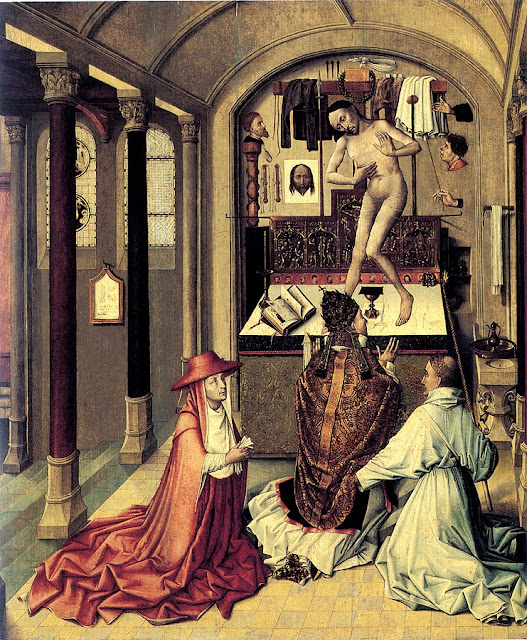Francisco de Zurbarán
Saint Gregory, c. 1626-1627
Oil on canvas
Height: 198 cm (77.9″); Width: 125 cm (49.2″)
Museum of Fine Arts of Seville
Francisco de Zurbarán (baptized
November 7, 1598 – August 27, 1664) was
a Spanish painter. He is known primarily for his religious paintings depicting
monks, nuns, and martyrs, and for his still-lifes. Zurbarán gained the nickname
Spanish Caravaggio, owing to the forceful, realistic use of chiaroscuro in
which he excelled. More on Francisco de Zurbarán
Pope Gregory I (c. 540 – 12 March 604), commonly known as Saint Gregory the Great, was Pope from 3 September 590 to 12 March 604 AD. He is famous for instigating the first recorded large-scale mission from Rome, the Gregorian Mission, to convert the then-pagan Anglo-Saxons in England to Christianity. The mission was successful, and it was from England that missionaries later set out for the Netherlands and Germany.
Francisco Goya
Saint Gregory, c. 1796 - 1799
Oil, canvas
190 x 115 cm
Museum of Romanticism, Madrid, Spain
Francisco José de Goya y Lucientes[A] (30 March
1746 – 16 April 1828) was a
Spanish romantic painter and printmaker. He is considered the most important
Spanish artist of late 18th and early 19th centuries and throughout his long
career was a commentator and chronicler of his era. Immensely successful in his
lifetime, Goya is often referred to as both the last of the Old Masters and the
first of the moderns. He was also one of the great portraitists of modern
times. More on Francisco José de Goya
Gregory is commonly credited with founding the medieval papacy and so many attribute the beginning of medieval spirituality to him. Gregory is the only pope between the fifth and the eleventh centuries whose correspondence and writings have survived enough to form a comprehensive corpus.
Robert Campin, (1375/1379–1444)
Mass of St. Gregory, c. 1440
Oil on panel
Height: 85 cm (33.4″); Width: 73 cm (28.7″)
Royal Museums of Fine Arts of Belgium
Gregory is shown saying Mass when Christ as the Man of Sorrows appears on the altar. The subject was most common in the 15th and 16th centuries.
Robert Campin (c. 1375 – 26 April 1444), now usually identified as the artist
known as the Master of Flémalle, is usually considered the first great master
of Flemish and Early Netherlandish painting. His identity and the attribution
of the paintings in the "Campin group" has been a matter of
controversy for decades. His life is relatively well documented for the period,
but he did not sign his paintings, and none could be securely connected with
him, whilst a corpus of work attached to the unidentified "Master of
Flémalle".
By 1406 he was active in Tournai, in today's
Belgium. His early work shows the influence of the International Gothic
painters the Limbourg brothers (1385 – 1416) and Melchior Broederlam (c. 1350 –
c.1409), but display a realistic observation than any earlier artists, which he
achieved through innovations in the use of oil paints. He was successful in his
lifetime, and the recipient of a number of civic commissions. Campin taught
both Rogier van der Weyden and Jacques Daret. He was a contemporary of Jan van
Eyck, they met in 1427. Campin's best known work is the Mérode Altarpiece,
dated c 1425-28, now in New York. More on Robert Campin
Saints Augustine and Gregory
If not Angles, but Angels Christian, c. 19th century
Glass inlay mosaic
Chapel of St Gregory and St Augustine, Westminster Cathedral, London
Gregory is known for his administrative system of charitable relief of the poor at Rome. The philosophy under which he devised this system is that the wealth belonged to the poor and the church was only its steward. He received lavish donations from the wealthy families of Rome, who, following his own example, were eager, by doing so, to expiate their sins. He gave alms equally as lavishly both individually and en masse.
Gregory was born into a wealthy noble Roman family with close connections to the church. On his father's death, Gregory converted his family villa into a monastery dedicated to Andrew the Apostle. Eventually, Pope Pelagius II ordained Gregory a deacon.
In 579, Pelagius II chose Gregory as his apocrisiarius (ambassador to the imperial court in Constantinople), a post Gregory would hold until 586, to ask the emperor for military aid against the Lombards. It soon became obvious to Gregory that the Byzantine emperors were unlikely to send such a force, given their more immediate difficulties with the Persians in the East and the Avars and Slavs to the North.
Gregory I the Great listens to the Holy Spirit while writing his “dialogues” or saints legends
Musée Condé, Chantilly
Gregory left Constantinople for Rome in 585, returning to his monastery on the Caelian Hill. Gregory was elected by acclamation to succeed Pelagius II in 590, when the latter died of the plague spreading through the city. Gregory was approved by an Imperial iussio from Constantinople the following September.
Please visit my other blogs: Art
Collector, Mythology, Marine
Art, Portrait of a Lady, The
Orientalist, Art of the Nude and The
Canals of Venice, Middle
East Artists, and visit my Boards on Pinterest
Images are copyright of their
respective owners, assignees or others. Some Images may be subject to copyright
I don't own any of these images -
credit is always given when due unless it is unknown to me. if I post your
images without your permission, please tell me.
I do not sell art, art prints, framed
posters or reproductions. Ads are shown only to compensate the hosting
expenses.
If you enjoyed this post, please share
with friends and family.
Thank you for visiting my blog and also
for liking its posts and pages.
Please note that the content of this post primarily consists of articles available from Wikipedia or other free sources online.






No comments:
Post a Comment
Note: Only a member of this blog may post a comment.